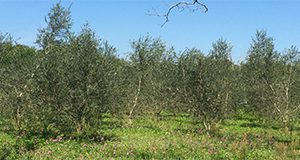Abstract
To remain in optimal health and produce optimal yield, olive trees need excellent nutrition, the right irrigation, and good care to help them stay healthy so that they can withstand injury from pests and diseases. This 10-page fact sheet written by Morgan Byron, Eleanor Phillips, and Jennifer L. Gillett-Kaufman and published by the UF/IFAS Entomology and Nematology Department touches on some aspects of olive tree health that will help improve your trees' natural resistance to pests and pathogens. At the end of the guide is a monthly care and observation schedule to help you recognize when you should begin scouting for key pests and when important grove management decisions should be made.
https://edis.ifas.ufl.edu/in1251
References
Allan, S. A., and J. L. Gillett-Kaufman. 2018. "Attraction of thrips (Thysanoptera) to colored sticky traps in a Florida olive grove." Florida Entomologist. 101(1): 61-68. https://doi.org/10.1653/024.101.0112.
Byron, M. A., and J. L. Gillett-Kaufman. 2016a. Olive fruit fly, Bactrocera oleae (Rossi) (Insecta: Diptera: Tephritidae). University of Florida Featured Creatures. Extension Publication No. EENY 645. Available at http://entnemdept.ufl.edu/creatures/FRUIT/TROPICAL/olive_fruit_fly.htm.
Byron, M. A., and J. L. Gillett-Kaufman. 2016b. Rustic sphinx, Manduca rustica (Fabricius) (Insecta: Lepidoptera: Sphingidae). University of Florida Featured Creatures. Extension Publication No. EENY 652. Available at http://entnemdept.ufl.edu/creatures/ORN/Manduca_rustica.htm.
Byron, M. A., J. L. Gillett-Kaufman, and S. A. Allan. 2015. Black scale, Saissetia oleae (Olivier, 1791) (Insecta: Hemiptera: Coccoidea: Coccidae). University of Florida Featured Creatures. Extension Publication No. EENY 620. Available at http://entnemdept.ufl.edu/creatures/CITRUS/black_scale.htm.
Connell, J. 2017. Olive Mineral Nutrition. University of California Cooperative Extension. (29 November 2017)
Collins, L., and R. H. Scheffrahn. 2001 (revised 2016). Red imported fire ant-Solenopsis invicta. UF/IFAS Featured Creature Document EENY-195. (28 November 2017)
Crane, J. H., J. Wasielewski, and C. F. Balerdi. 2018. Preparing for and recovering from hurricane and tropical storm damage to tropical fruit groves in Florida. HS1022. Gainesville: University of Florida Institute of Food and Agricultural Sciences. http://edis.ifas.ufl.edu/hs287.
Desouky, I. M., L. F. Haggag, M. M. M. Abd El-Migeed, Y. F. M. Kishk, and E. S. El-Hady. 2009. "Effect of boron and calcium nutrients sprays on fruit set, oil content and oil quality of some olive oil cultivars." World Journal of Agricultural Sciences 5: 180-185.
Elmore, W., and J. L. Gillett-Kaufman. 2017. Xylella fastidiosa and Olive Quick Decline: Symptoms and Identification of an Insect Vectored Pathogen. ENY998. Gainesville: University of Florida Institute of Food and Agricultural Sciences. http://edis.ifas.ufl.edu/in1165.
Ferguson, L. 2015. Olive production in Florida. UF/IFAS Olive Meeting 2015. http://smallfarms.ifas.ufl.edu/crops/fruits_and_nuts/pdf/3OliveMeeting2015.pdf (1 November 2017)
Fishel, F. M. 2013. PI246. The Importance of Keeping Pesticide Records. Gainesville: University of Florida Institute of Food and Agricultural Sciences. https://edis.ifas.ufl.edu/pi246
Gillett-Kaufman, J. L., S. A. Allan, J. H. Bosques-Mendez, and L. J. Buss. 2014. Plagas y hongos identificados en olivos (Olea europea) en Florida. ENY873. Gainesville: University of Florida Institute of Food and Agricultural Sciences. https://edis.ifas.ufl.edu/in1052.
Gillett-Kaufman, J. L., S. A. Allan, J. H. Bosques-Mendez, and L. J. Buss. 2014. Pests and fungal organisms identified on olives (Olea europaea) in Florida. ENY871. Gainesville: University of Florida Institute of Food and Agricultural Sciences. https://edis.ifas.ufl.edu/in1046.
Gillett-Kaufman, J. L., S. A. Allan, and L. J. Buss. 2015. "Manduca rustica (Lepidoptera: Sphingidae) damage on olive (Olea europaea; Lamiales: Oleaceae) trees in Florida." Florida Entomologist 98(4): 1272-1273. https://doi.org/10.1653/024.098.0443
Henricot, B., C. Gorton, J. Denton, and G. Denton. 2009. "Pseudocercospora cladosporioides, the cause of leaf spot on olive, a pathogen new to the United Kingdom." Plant Pathology 58: 803. https://doi.org/10.1111/j.1365-3059.2009.02079.x
Kitsaki, C. K., E. Andreadis, and D. L. Bouranis. 2010. "Developmental events in differentiating floral buds of four olive (Olea europaea L.) cultivars during late winter to early spring." Flora 205: 599-607. https://doi.org/10.1016/j.flora.2009.07.001
Layton, B. 2017. Control fire ants in commercial fruits, nuts, and vegetables. Mississippi State University Extension Publication 2494 (POD-03-16) (28 November 2017)
Linn, S. E., and J. L. Gillett-Kaufman. 2016a. Olive bud mite, olive leaf and flower mite (suggested common names), Oxycenus maxwelli (Keifer, 1939) (Arachnida: Acari: Eriophyidae). University of Florida Featured Creatures. Extension Publication No. EENY 651. Available at http://entnemdept.ufl.edu/creatures/FRUIT/TROPICAL/olive_bud_mite.htm.
Linn, S. E., and J. L. Gillett-Kaufman. 2016b. Olive psyllid (suggested common name), Euphyllura olivina (Costa 1839) (Hemiptera: Psyllidae). University of Florida Featured Creatures. Extension Publication No. EENY 656. Available at http://entnemdept.ufl.edu/creatures/FRUIT/TROPICAL/olive_psyllid.htm.
Lopez-Escudero, F. J., and J. Mercado-Blanco. 2011. "Verticillium wilt of olive: A case study to implement an integrated strategy to control a soil-borne pathogen." Plant Soil 344: 1-50. https://link.springer.com/content/pdf/10.1007%2Fs11104-010-0629-2.pdf https://doi.org/10.1007/s11104-010-0629-2
Malik, N. S., and J. M. Bradford. 2006. "Regulation of flowering in 'Arbequina' olives under non-chilling conditions: The effect of high daytime temperatures on blooming." International Journal of Food, Agriculture, and the Environment 4: 283-286. https://www.ars.usda.gov/research/publications/publication/?seqNo115=188994
Mulvaney, M. J., R. Mylavarapu, P. C. Andersen, M. Thetford, and J. L. Gillett-Kaufman. 2016.
Guide to olive tree nutrition in Florida. SS-AGR-402. Gainesville: University of Florida Institute of Food and Agricultural Sciences. http://edis.ifas.ufl.edu/ag405.
Phillips, A. J. L., I. C. Rumbos, A. Alves, and A. Correia. 2004. Morphology and phylogeny of Botryosphaeria dothidea causing fruit rot of olives. Mycopathologia 159: 433-439. https://doi.org/10.1007/s11046-005-0256-2
Selak, G. V., S. Perica, S. G. Ban, and M. Radunic. 2011. "Reproductive success after self-pollination and cross-pollination of olive cultivars in Croatia." HortScience 46: 186-191. https://doi.org/10.21273/HORTSCI.46.2.186
Spinardi, A., and D. Bassi. 2012. "Olive fertility as affected by cross-pollination and boron." ScientificWorldJournal 2012: 375631. doi: 10.1100/2012/375631 https://doi.org/10.1100/2012/375631
Taylor, R. K., C. N. Hale, and W. F. T. Hartill. 2001. A stem canker disease of olive (Olea europaea) in New Zealand. New Zealand Journal of Crop and Horticultural Science 29: 219-228. https://doi.org/10.1080/01140671.2001.9514181
Thetford, M., J. L. Gillett-Kaufman, and M. J. Mulvaney. 2015. Olives for your Florida landscape. EP 515. Gainesville: University of Florida Institute of Food and Agricultural Sciences. http://edis.ifas.ufl.edu/ep515.
Vossen, P. (Year unknown). Fertilizing olive trees. University of California Cooperative Extension. (28 November 2017).
Vossen, P. 2007. "Organic Olive Production Manual." University of California Agriculture & Natural Resources, California, USA. 112 pp.

